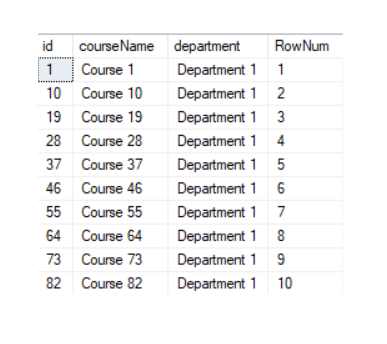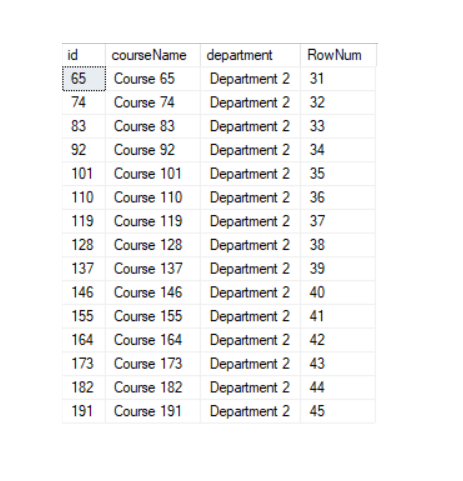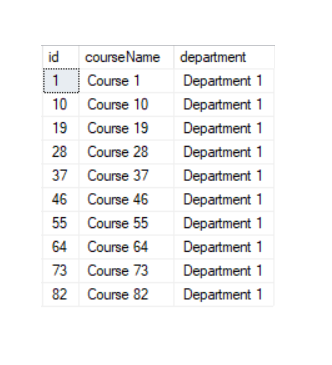In this article, let’s see various methods to implement pagination in SQL server.
In SQL server database, a table can have N no of records. Populating all these records in a grid control slows down the web page. You need to divide the number of records and populate it in the web page. Pagination is the process of splitting the number of records from a SELECT query result set into several pages. Based on the SQL server version, it can be implemented using ROW_NUMBER function or OFFSET FETCH clause.
Let’s create a sample table with some dummy data to see the implementation of pagination.
Create table with dummy data
Create a table ‘Course’ and insert dummy data using the below queries
CREATE TABLE Course
(
id INT PRIMARY KEY IDENTITY,
courseName VARCHAR(50) NOT NULL,
department VARCHAR(50) NOT NULL
);
DECLARE @count INT = 1, @depCount INT = 1
WHILE (@count <= 200)
BEGIN
INSERT INTO Course VALUES ('Course ' + LTRIM(@count), 'Department ' + LTRIM(@depCount))
SET @count += 1;
SET @depCount += 1;
IF(@depCount % 10 = 0)
SET @depCount = 1
END;
Now, the course table contains 200 records.
Pagination using ROW_NUMBER function
ROW_NUMBER function is introduced in SQL Server 2005. Let’s see how pagination can be implemented using this function. This method can be used in SQL server version 2005 and above.
DECLARE @PageNo INT = 1 DECLARE @RowsPerPage INT = 10 --Records Per Page DECLARE @Start INT, @End INT --Start and end record number in a page SET @Start = (@PageNo -1) * @RowsPerPage + 1 SET @End = @RowsPerPage * @PageNo SELECT * FROM ( SELECT *, ROW_NUMBER() OVER(ORDER BY department, id) AS RowNum FROM Course ) AS Programs WHERE RowNum BETWEEN @Start AND @End;
See the result below. It returns the first page with 10 records.

In the above script, change the value of the variable ‘@PageNo’ to view various pages and the value of the variable ‘@RecordsPerPage’ to show the records.
DECLARE @PageNo INT = 3 DECLARE @RowsPerPage INT = 15 --Records Per Page
See the result below after changing the variable values

Pagination using OFFSET FETCH clause
Another method to implement pagination in SQL server version 2012 or above is by using OFFSET FETCH clause. The Syntax of the OFFSET FETCH clause is
SELECT columnName(s) FROM tableName ORDER BY columnName OFFSET Rows_To_Skip FETCH NEXT Rows_To_Fetch ROWS ONLY;
The below query populates the first page with first 10 records.
DECLARE @PageNo INT = 1 DECLARE @RowsPerPage INT = 10 --Records Per Page DECLARE @RowsToSkip INT = (@PageNo -1) * @RowsPerPage SELECT * FROM Course ORDER BY department, id OFFSET @RowsToSkip ROWS FETCH NEXT @RowsPerPage ROWS ONLY;
And the result is,

Among the above mentioned methods, it is recommended to use the OFFSET FETCH method to implement pagination in SQL server 2012 and above for better performance.
Also, check “Generate comma-separated string from a table“
